|
 The purpose of my lecture is to inform
you of the instrument we created for evaluation and marking of rough diamonds above 3 carat. The purpose of my lecture is to inform
you of the instrument we created for evaluation and marking of rough diamonds above 3 carat.
First, I would like to note that we did not aim to make a fully automated device for rough diamond cutting.
Our aim was rather to create equipment allowing the expert to noticeably raise the processing efficiency on wide range of rough diamonds.
To illustrate the difference, let me bring the following example to your attention. Imagine an expert marking the same lot with and without using a leverage and
weight tables. No doubt, there will be stones marked equally. The more experienced is the expert, the more such stones there will be. But, I think you agree that the
efficiency will be greater in case of using the tools.
Now if the expert marked the same lot with our system, the efficiency will have extra gain.
Here you can see
results of the tests held with one of the best Russian experts in 1994.
The main features of the system are:
- Rough diamond marking and evaluation with deep analysis of internal characteristics.
- Control of bruiting and first-step polishing of a diamond.
- Finding new options of marking.
- Creating of electronic passport for rough and polished diamonds.
The biggest effect can be achieved with rough diamonds above 5 carats. The yield increases by 1-4%, clarity improves by one grade, and some
diamonds move one position up in weight grading.
The best results were obtained with the forms of SHAPES, FLATSHAPES, CLEAVAGES, and qualities of
SPECULATIVE and DARK.
One of the main benefits of the present system is that the
fully automated processes of model creation and searching
for options of marking allow meddling of the operator, who
can move diamonds, change their parameters, set the marking
plane position and etc. This allows for most complete exploiting
of the expert's knowledge and the computing power of the system.
The program features:
- Detecting the most profitable option of rough marking.
- Diamond model building with respect to optical distortions (non-parallel projection).
- High precision estimation of future diamond weight, position of inclusions in future diamonds. Observing real and imaginary inclusions.
- Automated search for the largest possible diamond with
respect to parameters and inclusions, estimating mutual
location of the future diamond
and inclusions with precision of at least 100 micrometers.
- Automated drawing of the marking line.
- Various cut shapes: ROUND diamond, MARQUISE, PEAR, EMERALD, FLOWERS, PRINCESS and others.
- Marking of a rough into more than two polished diamonds.
- Efficiency analysis of double warps of the marking line.
- Calculations of inclusion positions in case of cuvette with immerse liquid.
Technical features of the optical set:
- Effective processing of the rough from 1 to 20 carats is supported due to the zoom feature with range of 1 to 3.
- Robust is setting of inclusions up from VS2/SI1.
- 70 micrometer average precision of surface model building.
- Marking line drawing in two opposite directions, with angle precision of 0.8 of degree and linear translation precision of 100 micrometers.
- Two light sources with computer-driven brightness for effective inclusions recognition.
- Stone rotations around two axes.
Description of the System
The operator can apply both fully automated and interactive methods, considering the system as a simple 3-dimensional intelligent estimator (leverage). Combination
of different methods is essential with rough diamonds above 10 carats.
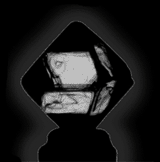 |
The crystal holder has up to two rotational freedoms and up to 2 linear
translation freedoms. Usually, from 50 to 200 projections of the sample rotated around the vertical axis are used for creation of electronic crystal model. With complicated shapes
(MACCLES, MAKEABLES, and CLEAVAGE), it is useful to add horizontal rotation projections. |
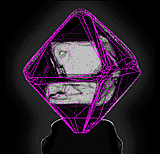 |
It takes about 1.5-2 minutes to build the surface model of a rough diamond of
3 carats. During that process, 50 projections are built, and the precision of 100 micrometers is achieved. About 200 projections are necessary for a 20-carat diamond model. The
software allows observing the backside bones of a model (those depicted with dashed line), with or without respect to refraction. The model on the right picture is shown with
refraction. |
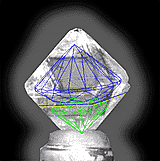 |
Once the surface model is built, the operator can run procedures
for detecting the maximum polished diamond, maximum yield marking, and maximum total price of two diamonds. (At this stage, the optimizations are done without respect to i
nclusions).
|
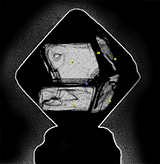 |
Next step is to set the inclusions in the model. The images of inclusions
pointed to by operator are shown in yellow. The actual locations are shown in blue. The operator has no need to set each inclusion. He or she can consider the most important
ones and proceed with them only. |
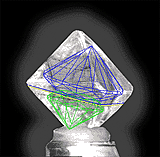 |
Different options of marking are found during this step. Those options are
calculated considering inclusions and processing conditions. |
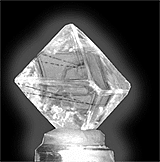 |
Here is a DARK STONE of 12.85 carats with two options of marking.
The inclusion is under the crown of the larger diamond on the depth of 500 micrometers. We can see images of the inclusions (including the reflected ones) within the future diamond
from various points of view. The upper line determines the marking option with the largest clear diamond. |
Now the operator can interactively correct the marking considering conditions of the processing, such as using natural facets of a diamond.
If the expert does not want the option
generated automatically, he or she can set the marking position manually and run the optimizing process for it.
Conclusions
- Non-contact marking technique allows working with stones of any shapes.
- Inclusion recognition (location) AND processing of non-convex surfaces became easy by two-rotation freedom, two sources of illumination (front and back)
and software support for inclusion localization.
- Optimization with all parameters of the standard cut taken
into account.
- Advantage in efficiency by precision withdrawal of inclusions and yield raise.
- Light (hardware-free) version of software for training of a new expert.
- Optimization on the base of microtomographic data set
for non-destructive shape analysis and internal inclusion
localization.
|




















